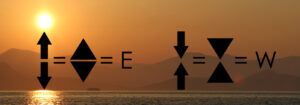Cardinal marks indicate various hazards to navigation (shoals, reefs, shipwrecks…) and help us avoid them by showing the side we need to sail on. The marks are black and yellow in color, with the top sign being a double cone, which is the most important element of cardinal marks during the day. They also have a white light, which is the most important element of cardinal marks at night.
There are four different cardinal marks for north (N), south (S), east (E), and west (W). To avoid the hazard indicated by the mark, we must sail around it on the side it points to. The marks for north and south are easy to recognize. The north mark has both cones pointing upwards, and the south mark has both cones pointing downwards. It is a little harder to remember which cone combination indicates west and which indicates east. If we don’t know what the mark exactly means, a maritime accident can easily happen. If we are not sure what a mark means, we should stop the vessel, check, and only then continue sailing.
Cardinal Mark
The image above shows the cardinal mark for north (N), which is located 50 meters north of the island Srednjak in Supetarska Draga on the island of Rab. It marks a shoal that we must sail around on the northern side.
Recognition by the Sun’s Movement
The first method is recognizing cardinal marks for west or east by the direction of the sun’s movement relative to the sea horizon. Imagine that the peaks of the cones are always pointed in the direction of the sun’s movement.
The sun sets in the west and falls towards the sea horizon. The image of two cones, where their peaks are pointed towards each other, associates with the sun falling towards the sea horizon and the sunset. Based on this, we can correctly deduce that we are looking at a cardinal mark for west. In the case of sunrise, the sun rises and ascends above the sea horizon. The cones of the cardinal mark for east are pointed in the opposite direction (down and up from their junction). Based on this, we can correctly deduce that we are looking at a cardinal mark for east.
Recognition with the letters W or E
The cardinal mark for west has two cones pointed towards each other. If we draw their outline on the right or left side, we get the letter W, which is the English abbreviation for west. Based on this, we can correctly deduce that we are looking at a cardinal mark for west.
The cardinal mark for east has two cones with oppositely directed peaks. If we draw their outline on the right or left side, we get the letter E, which is the abbreviation for east. Based on this, we can correctly deduce that we are looking at a cardinal mark for east. We usually observe the combinations of the direction of the two cones on top of the cardinal mark only when we are close enough to it. The boat operator must always and immediately recognize the cardinal mark, both during the day and at night, otherwise, there is a risk of sailing towards an obstacle and at least grounding the vessel.
Source: eNavtika.si



